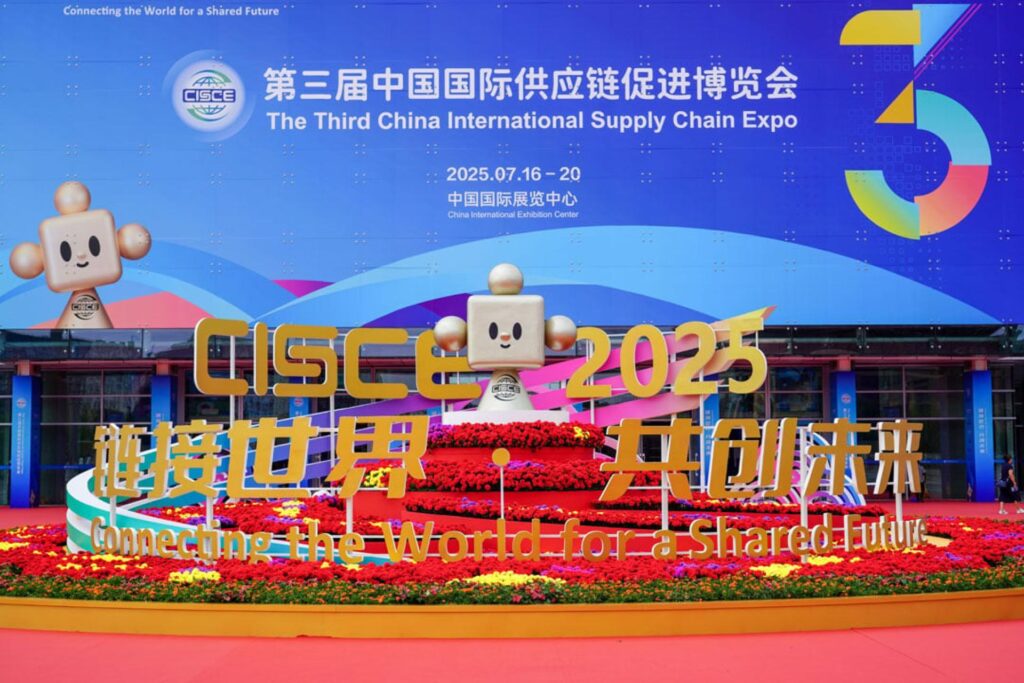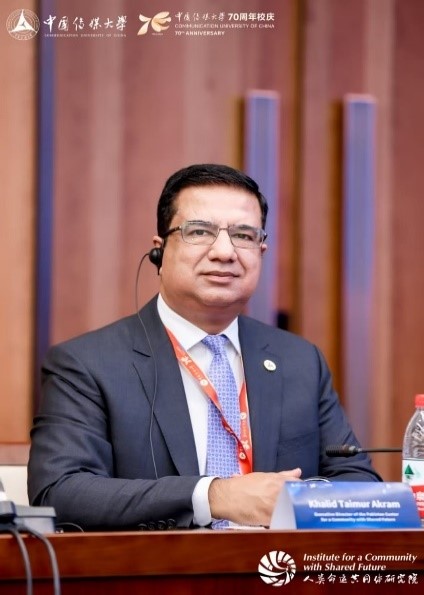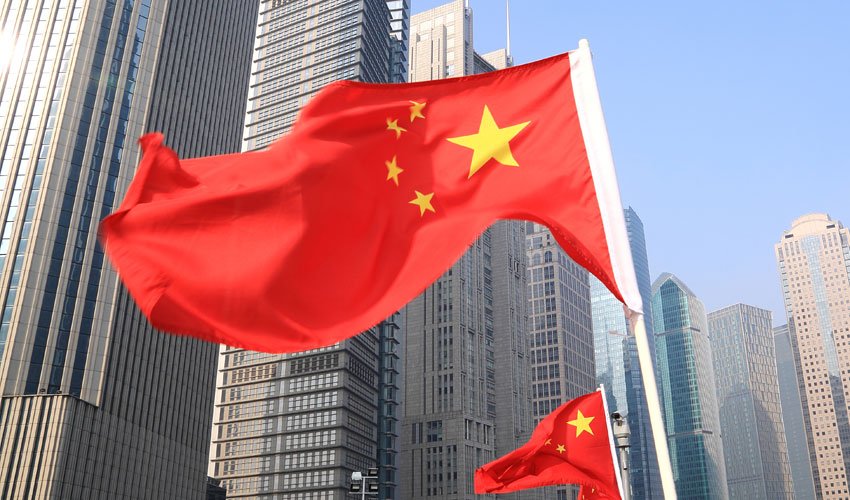

Written by Mr. Khalid Taimur Akram is the Executive Director, Pakistan Research Center for a Community with Shared Future (PRCCSF).
In an era of rising geopolitical tensions and rapidly evolving technology, global supply chains are experiencing one of the most significant transformations. Governments and enterprises alike are seeking to adapt to these changes by creating supply networks that are not only more efficient but also resilient, innovative, and sustainable. At the heart of this global restructuring lies China, a key player in the world economy and an indispensable link in global supply chains.
Against this backdrop, the China International Supply Chain Expo (CISCE) emerges as a significant initiative to promote cooperation, stability, and innovation within international supply networks. Now in its third edition, the Expo, held in Beijing from July 17 to July 21, 2025, under the theme “Connecting the World for a Shared Future,” is a testament to China’s commitment to strengthening global supply chain resilience and promoting open international collaboration.
The global economy faces turbulent headwinds. Protectionist policies, decoupling trends, supply chain bottlenecks, and economic slowdowns are forcing industries across the board to recalibrate. In this fragile landscape, the CISCE stands out as a symbol of stability and mutual benefit. Attracting over 650 enterprises and institutions from 75 countries, regions, and international organizations, the expo is a comprehensive platform for industrial matchmaking, policy dialogue, and technological exchange organized by the China Council for the Promotion of International Trade (CCPIT). CISCE is structured around six major supply chains, such as advanced manufacturing, clean energy, smart vehicles, digital technology, healthcare, and green agriculture, plus a dedicated supply chain service area showcases China’s holistic approach to nurturing interconnected and future-ready industries.
Enhancing Resilience Through Diversification & Innovation
Supply chain resilience today is defined not only by the ability to withstand shocks but also by the capacity for rapid recovery and sustainable growth. CISCE provides an ideal platform for companies to explore diversified network strategies and build agile, responsive supply chains.
Multinational corporations can identify optimal suppliers within China, thereby reducing procurement and logistical costs while enhancing their market competitiveness. Simultaneously, Chinese enterprises gain exposure to international best practices, advanced technologies, and new export opportunities, resulting in mutually beneficial, win-win collaborations. Moreover, the increasing presence of overseas exhibitors accounting for 35% of participants this year reflects growing global interest in the Chinese market and a shared recognition of China’s pivotal role in global value chains.
One of the key contributions of CISCE lies in its ability to promote regional coordination and economic integration. Initiatives like the New International Land-Sea Trade Corridor are leveraged during the expo to improve logistical routes, enhance transportation efficiency, and reduce overall costs for manufacturers and exporters. This regional cooperation promotes synchronized growth between inland and coastal regions, amplifying the benefits of China’s “dual circulation” development strategy. By fostering synergy between domestic and international economic flows, CISCE serves as a vehicle for deeper integration and shared prosperity across borders. Innovation is a cornerstone of modern supply chains. As such, CISCE places a strong emphasis on technological advancement and intellectual property. The expo features a dedicated innovation chain exhibition area, hosting renowned institutions such as the World Intellectual Property Organization (WIPO) and the State Intellectual Property Office of China, alongside pioneering enterprises from sectors like digital tech and new energy. These engagements stimulate enterprise-level innovation, encourage knowledge exchange, and promote the transformation of scientific achievements into scalable industrial applications.
Another highlight of CISCE is its high-end networking ecosystem. The expo hosts various thematic forums and matchmaking events, drawing experts, policymakers, and Fortune 500 executives to discuss pressing global supply chain issues. These engagements help companies navigate international markets, forge strategic partnerships, and explore investment avenues. The CISCE Launch Zone, a new feature in this year’s edition, offers companies a platform to unveil new products and technologies, enhancing brand visibility and expanding market influence. Complementing this are strengthened policy and administrative services, including customs facilitation, supervision, and consultation provided by Beijing Customs, as well as policy support from China’s top market regulators.
China will remain in a central role in global supply chains as China has held the title of the world’s top manufacturing economy for over 15 years, accounting for more than 40% of the global production of major industrial goods. As the second-largest consumer market globally, with a growing middle-income demographic and a per capita GDP exceeding $10,000, China provides a solid foundation for demand-driven innovation. China ranks among the top countries in R&D investment, patent filings, and innovation clusters, transitioning from “world’s factory” to a global innovation engine.
Boasting over 800 million workers and 10 million annual university graduates, China is leveraging its talent dividend to support advanced manufacturing and high-tech industries. Through continuous regulatory reform, institutional opening-up, and alignment with international standards, China has cultivated a predictable and transparent investment environment. Foreign enterprises continue to expand operations in China, drawn by its reliable infrastructure, integrated industrial zones, and innovation potential. CISCE embodies these strengths by providing a practical and vibrant venue for collaboration.
Paving Way for a Sustainable and Digitally Connected Future
China’s supply chain evolution is increasingly guided by principles of sustainability and digitalization. From green agriculture and renewable energy to electric vehicles and smart logistics, the emphasis is shifting toward decarbonized and intelligent supply systems. China’s electric vehicle sector, for example, was a major highlight at the Expo. Companies showcased advancements in smart mobility, AI integration, and sustainable battery technologies. German firms and others noted how China’s rapid adoption of clean transport solutions and digital manufacturing sets a global benchmark.
CISCE is helping to accelerate the integration of digital and green technologies across the value chain, aligning global supply chains with the Sustainable Development Goals (SDGs) and climate targets. In a fragmented world grappling with uncertainty and distrust, the China International Supply Chain Expo stands as a beacon of cooperation, innovation, and openness. It not only affirms China’s strategic vision for global industrial resilience but also offers actionable pathways for businesses worldwide to thrive in an interconnected economy by bringing together stakeholders from across industries and sectors, shaping a more balanced and connected world economy.


